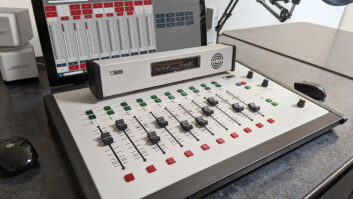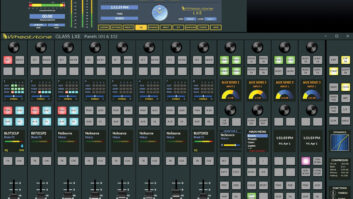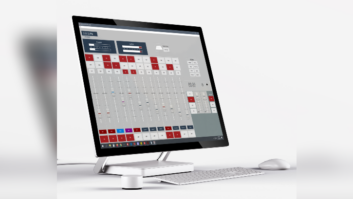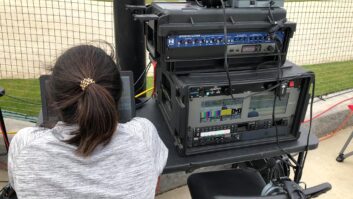(click thumbnail)Arrakis X-Mixer Digital ConsoleI, along with staff engineers Andy Mika and Brian Longstreth, spent an afternoon with an Arrakis X-Mixer-14 in our Columbus engineering shop. The 14 – a smaller 10-channel version is also available – is packed with an array of hardware and software features. Most notably, this console plays in digital, analog and with or without a PC.
The X-Mixer is the latest of Arrakis’ digital consoles, actually the company’s third. The Revolution series was introduced in the late 1990s and the Nova-10C – little brother to the X-Mixer – in 2002.
The base console supports 14 audio source inputs: two mic, 10 stereo analog line and two AES3 digital. The option board, standard on the X-Mixer-14, gives the user eight more digital in and two more mic preamp patch points, for a total of two to four mic, eight to 10 analog line and 10 AES inputs. Each input can be assigned to any of the 14 faders or the 12 source selects.
In most applications, S/PDIF sources can interface with the AES inputs of the console by simple transformer matching, or impedance matching by adding a loading resistor.
In our tests, we drove an AES input with a 44.1 kHz AES output from a Denon CD player. Although the console bus operates at an internal sample rate of 48 kHz, the digital inputs’ sample rate converters lock everything together. Analog inputs get A/D’d in 24-bit Delta-Sigma with low latency.
Arrakis has done a nice job silkscreening inputs and outputs on the motherboard while still using its AMP MR series receptacles/connectors. Crimping tool and pins are supplied; just add wires. Installation is straightforward.
The console has a nice look and feel, thanks to the color scheme, all-electronic switching, P& G series faders and LED tallies. In tight space situations, you get a lot of console per square inch. Servicing is easy (all from up top), and most ICs are socketed.
The console weighs less than 35 pounds, and fits into spaces where other gear won’t. When we pulled the console from the shipping box, I thought they forgot to ship the power supply, the rather large “black box” that typically attaches to the cabinetry underside with the interconnect cable. Instead I saw a “line lump,” a fully encapsulated power pack; AC plug on one end, DIN plug on the other.
Seeing this made us laugh, realizing how far technology has come and how efficient this console operates. All DC power rails are derived from ‘the lump’ and it’s the easiest supply you’ll install.
On the bus
Product CapsuleThumbs Up
Line-lump power pack
PC option expands console’s capabilities
Compact footprint
Thumbs Down
“Last state” settings of fader on/off logic not maintained upon power cycle
Lacking peak-indicating LEDs
Digital clipping artifacts if levels and trim are not adjusted properly
Price: $5,495
Contact Arrakis Systems in Colorado at (970) 461-0730 or visit www.arrakis-systems.com
Without the use of a PC, you can operate in a conventional sense; say a source inbounds on fader 4 and that source stays there. Label the pot appropriately and all is well. With the supplied Windows-based software and a serial connection to the motherboard, you open a whole new world of “soft control.”
Take that same source coming in on fader 4, and reassign it to fader 10, 3, 7, or 3 and 4 at the same time. Adjust fader trim (in-hand operator gain), source logic, off-line mix and count-up timer control. You can enable/disable Autocue and Autocue attenuation.
Sources can be ‘moved’ without touching a wire or connector. If one operator likes their CD players on faders 3 and 4, but another prefers the automation server elsewhere, it’s no problem. You can restore defaults with a mouse click. Once you save those settings, non-volatile RAM retains the setup, even after removing the PC and power cycling the console.
The only issue we had with the board on a power cycle sequence was the fact that “last state” settings of the fader on/off logic are not maintained. All channels resort to “off.” A UPS on the console (and you certainly wouldn’t need a big one for the line-lump supply) would resolve this issue in most situations, assuming you have an emergency power generator at your location.
The PC option is wonderful, but is not necessary for most station applications. There are two banks of DIP switches on the motherboard to perform basic setup for things like Autocue, tally logic, phone channel setup, coarse channel gain set, internal mic preamps in or out, in-hand fader gain and monitor muting.
On the business side of running the board, you have three busses: Program, Audition and Mono. The Program and Audition busses are stereo, and have simultaneous analog and AES3 outputs. The Mono bus is strictly analog, but works nicely in developing a mix-minus bus for a remote location or ISDN backhaul feed.
The Cue bus does multitasking, including prefader mic send to the caller mix-minus bus and pre-fader audio to the cue system and operator headphones. The entire telco interfacing is flexible and operator-friendly.
Standard with the console is a remote line selector (RLS) in a 6×2 format. With the PC, you’re soft here, too. Without the PC, the RLS defaults to the last two faders on board (not hardwired).
The Control Room Monitor and Timer are easy and functional. Monitor any bus, one external source (like an air signal) and talkback to a remote. Line level outputs for a monitor and headphone amp get you “hearing” your mix.
I still like watching VU meters. The X-Mixer has five of them, monitoring the three output busses, and a count-up timer. One feature I believe the console needs is peak-indicating LEDs. The maximum output level of the console is +24 dBu, and while this is a comfortable margin of headroom above 0 VU, once you exceed it in this console, the digital bus gets nasty at “all ones.” In both the analog and digital outputs, you’ll know – and so will your listeners – when the board operator is “pinning the needles.”
Unlike analog consoles that typically give that distorted, over-driven grunge sound when pushed into clipping, digital clip is revealed in either a ‘hole-punch’ in the audio, or in this case a nasty ripping/tearing sound. With proper setup, including gain structure, in-hand fader control and operating training, you should be able to avoid this problem.
At the end of our afternoon on the bench, we found the X-Mixer to have many nice features in a compact footprint, and an attractive price. Arrakis has taken its experience from consoles in the field and stepped into the digital era with X-Mixer. The board is a good value, and a good mix of traditional, time-proven design and digital flexibility.













